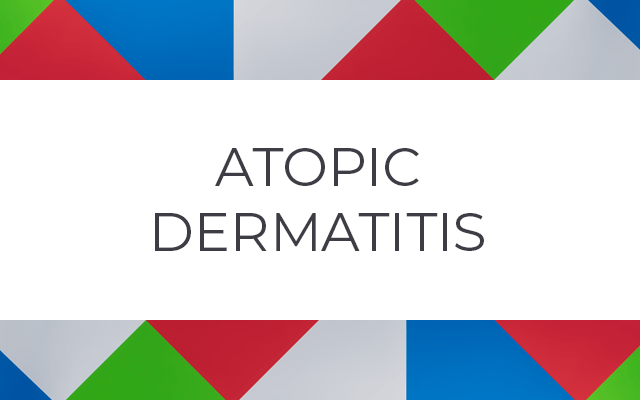
Management of mild atopic dermatitis
Matthias Schmuth (Austria)
Successful bench-to-bedside translation of basic scientific findings of atopic dermatitis (AD) into therapeutic interventions for patients depends on the understanding of clinical features, differential diagnosis, subtypes of atopic dermatitis and potential complications.
The expanding armamentarium of diagnostic criteria and therapeutic options opens a new era for improved medical care for AD patients, ranging from the smart use of emollients to strengthen the permeability barrier of the skin to recent developments of anti-inflammatory topicals and educational programs for patients and their families.

Treatment of severe atopic dermatitis
Pedro Mendes Bastos (Portugal)
Severe atopic dermatitis (AD) is an immune-mediated dermatological disease with a substantial disease burden that largely exceeds its skin manifestations. The heterogeneity of clinical presentation, comorbidity pattern and response to treatment makes the treatment of severe AD a true challenge.
Transitioning from an era where no drugs were approved, to a time where innovative systemic treatments are available is a demanding task for practicing dermatologists.
The aim of this presentation is to provide an update on the current therapeutic landscape for severe AD, highlighting the differences between classes and discussing the pros and cons of each treatment modality. Besides pharmacological therapy, other complementary therapeutic approaches must be considered to deliver the best holistic care to severe AD patients.


Treat-to-target in atopic dermatitis
Christian Vestergaard (Denmark)
“Treat-to-target” in the context of atopic dermatitis has recently been widely discussed. This might be driven by the impressive results given by new biological treatments and small molecules, which have heralded a new era in which we now discuss EASI 75, and possibly even EASI 90, with which doctors and patients might even hope for remission of the disease. However, what does treat-to-target actually mean? Is it only a question of EASI measurement or is there more to it?
Another concept that has made its way to the atopic dermatitis scene is treatable traits. Atopic dermatitis is a disease with many traits, (e.g. itch, rash, oozing and skin infection), with additional traits or co-morbidities form other organs than the skin (e.g. asthma, eosinophilic esophagitis, allergies), traits including psychiatric symptoms such as depression, anxiety and ADHD, and lastly social symptoms such as stigmatization, loss of education and life opportunities.
Treat-to-target as a concept is thus much more complex than deciding whether EASI 75 or EASI 90 should be the final target. Moreover, among dermatologists and patient organizations alike, we need to discuss what the final goal for treatment should be. On a daily basis, we must agree – with each individual patient – which treatment targets to prioritize, and what should be considered a success.


New treatments for atopic dermatitis
Patrick Brunner (Switzerland)
Atopic dermatitis is the most common chronic inflammatory skin disease. It is an excellent example as to how an increase in the pathophysiological understanding of a disease has directly resulted in innovative treatment options. The session will provide a historical overview of the treatment options for atopic dermatitis that have been developed in recent years, in addition to immunological context to current and future targeted treatments. These targeted treatments are not only safe and efficacious therapeutics, but they also help us better understand skin immunity altogether.


Microbiome modulation in atopic dermatitis
Norbert Kiss (Hungary)
Our skin is home to millions of bacteria, fungi and viruses that, together, form the skin microbiome. The composition of microbial communities is primarily dependent on the microenvironment of the skin site. Bacteria are the most abundant kingdom across all sites.
Although the skin microbiome can change over time, inter-individual variability is greater than the temporal variability within an individual. Commensal bacteria can directly block the colonization of pathogenic microbes by occupying an ecologic niche and also by the secretion of antimicrobial factors, including bacteriocins, modulins, propionic acid, and antimicrobial peptides. In addition, commensals can give feedback to the immune system to stimulate a host defense against disease-causing microbes, but also to promote immune tolerance, reducing the inflammation, and severity of the disease.
Although the pathogenesis of atopic dermatitis is complex and not completely understood, it appears that defects in the skin barrier function, environmental and infectious agents play a key role. Microbial dysbiosis, with reduced microbial diversity and overrepresentation of Staphylococcus aureus and Malassezia species is a characteristic feature of the skin of atopic dermatitis patients. Technological improvements have advanced our ability to characterize the microbial communities of the skin, increasing our knowledge on the disrupted host–microbiota relationship in atopic dermatitis.
The importance of the establishment of an appropriate immune response to microbes in early life and novel mechanisms for the modulation of skin microbiome have been recently elucidated. Various probiotic and prebiotic preparations, as well as skin microbiota transplantation, are finding their way to clinical applications. Recent clinical trials show that microbiome-based therapeutics have a great potential to be applied in the treatment of atopic dermatitis, but the specific strains of bacteria and mode of application that would result in a lasting effect is yet to be further investigated.





